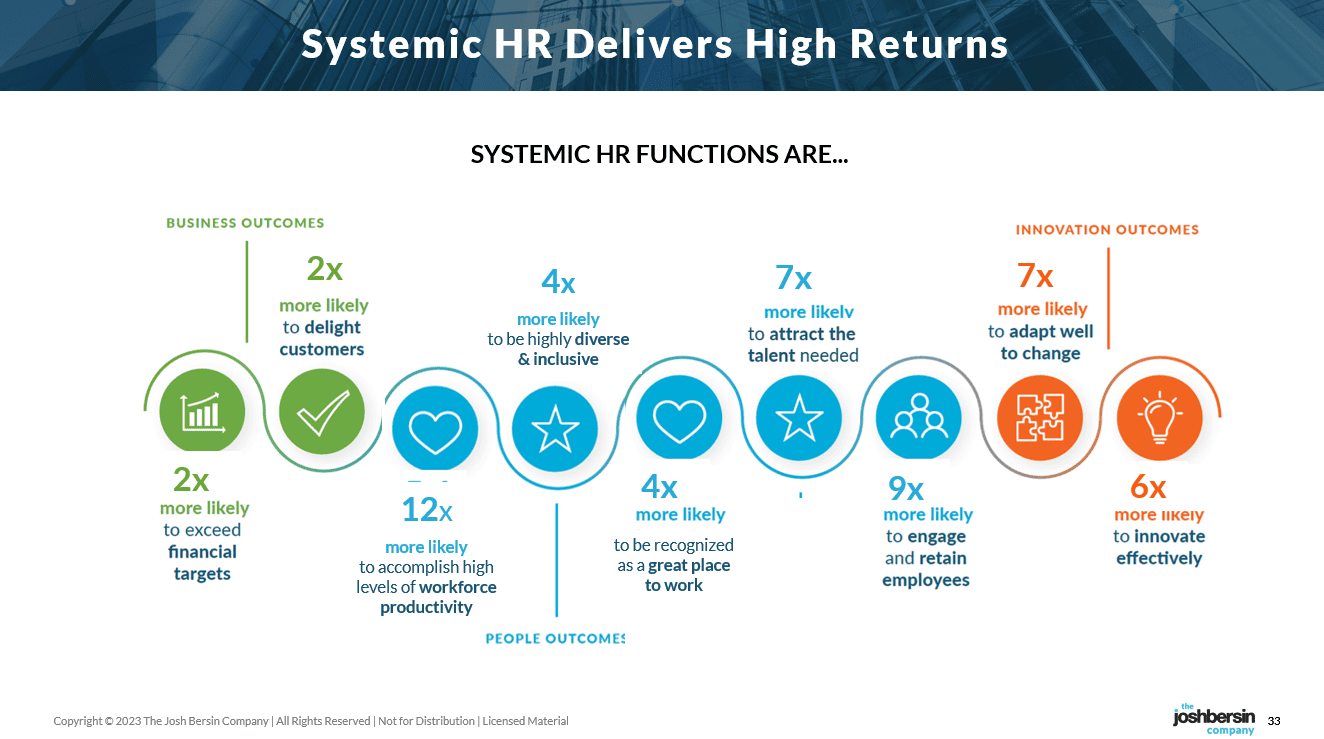Why It’s Time For A New Era In Human Resources. Enter Systemic HR.
Next week we will be previewing our new research on the Human Resources function, and the findings are important. Let me summarize the narrative and I promise you’ll hear more in the coming quarter.
Human Resources has been around for hundreds of years. Originally defined as a back-office administrative function, HR teams were always looked upon as clerks, administrators, recruiters, or training managers. In the early 1900s we relied on HR to manage payroll, the job hierarchy, and the overall design of rewards, cascading goals, and rewards.
 |
In the 1950s and 1960s, as conglomerate business models ruled the economy, HR professionals moved up the ranks. In addition to taking care of these administrative processes, we took on the responsibility for leadership development, succession management, and the “pre-hire to retire” career model. Most employees worked in the same company for a long time, so HR teams helped design our progression, pay bands, and various programs (including retirement) to manage that simple process. Corporate Universities, targeted toward this institutional career model, also became the rage. And we started to deal with unions, labor relations, and new regulations around retirement.
In the 1970s and 1980s we entered a war for talent, accelerated by the technology revolution in the late 1990s. This shifted HR towards building a highly muscular talent acquisition function and also forced companies to invest in sourcing, assessment, and advanced recruiting tools. Companies invested in complex stacks of recruiting technology and similarly found that retention, engagement, and culture were part of the equation. So we took our experience in industrial psychology and built a deep set of skills in surveys, retention analytics, and engagement.
As the digital revolution grew, another issue emerged. Employees started feeling burned out with all their new tools and HR was asked to look at productivity, retention, and what we now call “employee experience.” So a new domain emerged: HR teams trying to simplify the massive stack of technologies in HR, developing programs that were user-centric and design oriented, and coming to grips that “HR is not here to do things TO people but FOR people.”
Then we had the pandemic. So we added a focus on remote work, hybrid work, mental health, remote-work culture, and a newfound realization that our “employees” were often gig workers, contractors, or part-time staff. So we now had to deal with a whole new set of disciplines, and invested heavily in wellbeing programs, hybrid work policies, and even better employee listening, communication, and employee experience tools.
Add to this a heavy dose of inflation and a huge need for new skills, and we realized our pay practices were out of date. So now, in the early 2020’s, we had to focus on pay equity, localized pay practices, and truly global recruitment, pay, and new rewards strategies for a company made up of full-time, part-time, and gig workers all over the world. And in the middle of all this, coming out of the pandemic, we woke up to the fact that a flatter organization and more agile work model was needed, so we all had to get comfortable with the domain of organization design.
While all these new topics, challenges, and domains emerge, a more existential change was happening. Our workforce and entire company became more diverse. Starting in the 1960s with Affirmative Action, we learned that our company’s performance was dependent on psychological safety, inclusion, and a forced-march into diversity and open-minded thinking. Today we have more than 10 definitions of “gender,” many races and nationalities to embrace, and a newfound focus on generational diversity, cognitive diversity, and respect for people with disabilities.
And today, as we enter the Secular Labor Shortage, another set of issues emerge. Every company is worried about its skills, its ability to hire and retain people, and the need to create a culture of learning and growth in an environment of competition, technology change, and highly competitive markets. So HR leaders and their teams are grappling with skills taxonomies, AI-enabled tools for sourcing, development, and growth, as well as a massive need to upgrade, replace, and improve the technology environment through AI.
How in the world has HR kept up?
It hasn’t been easy.
As you’ll see from our research, more than 80% of HR teams and professionals are simply overwhelmed by the change. Our profession has shifted from one of compliance to one of design, consulting, and technology. And our entire function, the HR team or HR organization, has morphed from a focus on compliance and service-delivery to one of productized solutions, intelligent data and insights, and a need to be consultants and advisors, not just generalists and support agents.
 |
We believe a new world has arrived, and as you’ll see from the research, it points to a need for a new set of HR capabilities, a new focus for HR leaders, and a new way to manage and operate the HR function. The companies that learn to adapt and evolve into this model are outperforming their peers: they are four-times more likely to be best-places to work, three-times more likely to be category leaders in their industry, and four-times more likely to be revenue growth and profit leaders in their market.
 |
And as we’ve discovered, Systemic HR is not a “model” that you can hire a consulting firm to implement. Rather it is an evolution, a realization that the role and function of HR has changed, which in turn leads to a new operating model, new HR job roles, deeper HR skills, talent intelligence, systemic people analytics, and much more cross-functional problem-solving.
As we studied the HR profession we found more than 500 “job titles” within HR. Systemic HR brings much of this specialization together, enabling companies to rely on their human resources team to diagnose problems, develop systemic solutions, monitor productivity and various talent practices, and advise senior leaders on a wide range of people issues.
This is one of the most exciting times I’ve seen in HR, and we feel privileged to explain this to you. Stay tuned for more information as we roll out Systemic HR, and for those of you coming to the LinkedIn Talent Connect conference in New York,
I hope to see you at the debut.
Additional Resources
Why We Are Entering A Secular Labor Shortage
Systemic People Analytics: A New Way To Think About Employee Data
The Role Of Generative AI In HR Is Now Becoming Clear
Deep Dive on AI in HR (Research Study)
Introducing The Organization Design SuperClass
The Josh Bersin Academy: End-To-End Professional Development for HR


